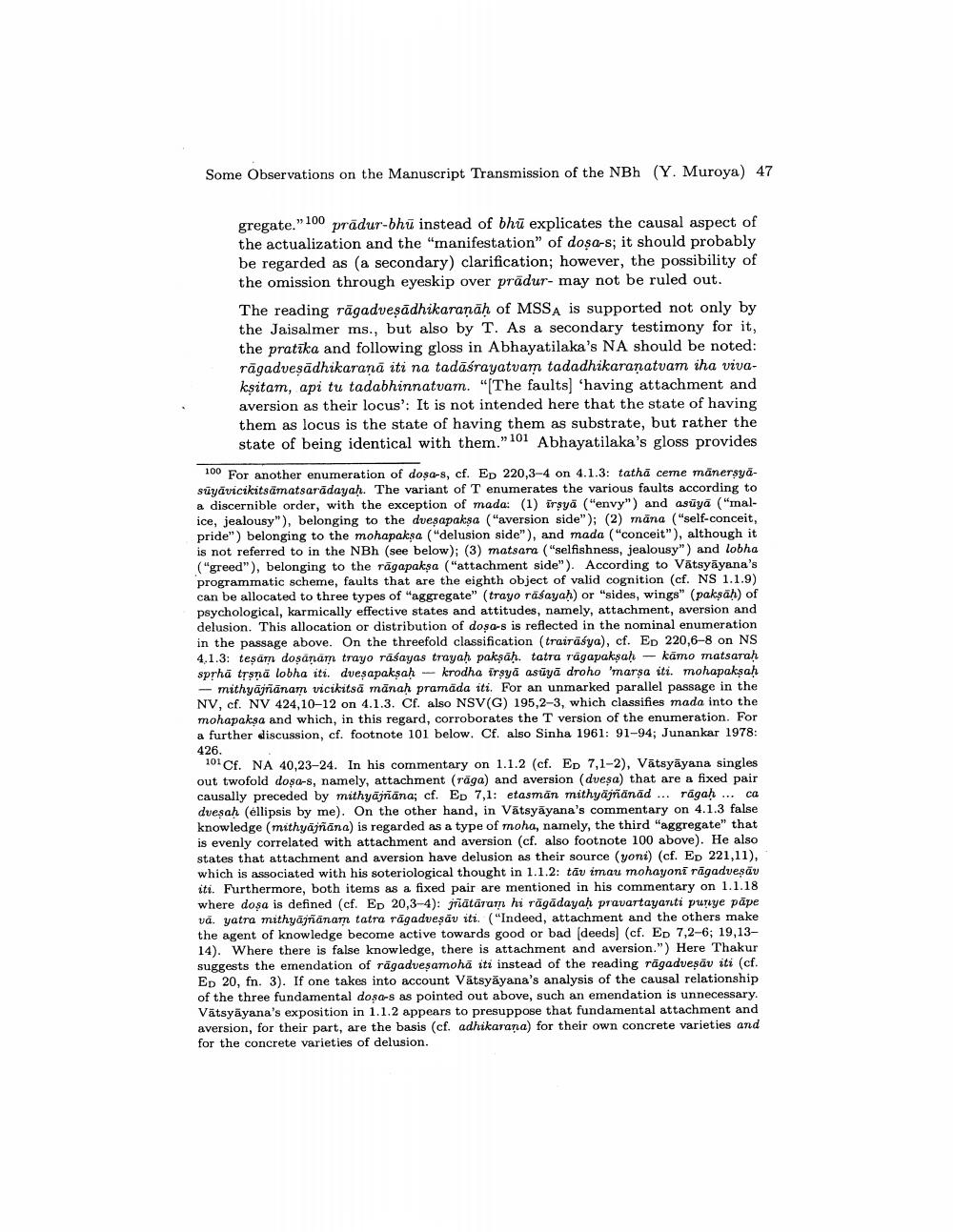________________
Some Observations on the Manuscript Transmission of the NBh (Y. Muroya) 47
,, 100
gregate." pradur-bhu instead of bhu explicates the causal aspect of the actualization and the "manifestation" of dosa-s; it should probably be regarded as (a secondary) clarification; however, the possibility of the omission through eyeskip over pradur- may not be ruled out.
The reading ragadveṣādhikaraṇaḥ of MSSA is supported not only by the Jaisalmer ms., but also by T. As a secondary testimony for it, the pratika and following gloss in Abhayatilaka's NA should be noted: ragadveṣādhikarana iti na tadaśrayatvam tadadhikaranatvam iha vivakṣitam, api tu tadabhinnatvam. "[The faults] 'having attachment and aversion as their locus': It is not intended here that the state of having them as locus is the state of having them as substrate, but rather the state of being identical with them." 101 Abhayatilaka's gloss provides
100 For another enumeration of dosa-s, cf. Ep 220,3-4 on 4.1.3: tatha ceme manerṣyāsuyavicikitsämatsaradayaḥ. The variant of T enumerates the various faults according to a discernible order, with the exception of mada: (1) irṣya ("envy") and asuya ("malice, jealousy"), belonging to the dueşapaksa ("aversion side"); (2) mana ("self-conceit, pride") belonging to the mohapaksa ("delusion side"), and mada ("conceit"), although it is not referred to in the NBh (see below); (3) matsara ("selfishness, jealousy") and lobha ("greed"), belonging to the ragapakṣa ("attachment side"). According to Vätsyāyana's programmatic scheme, faults that are the eighth object of valid cognition (cf. NS 1.1.9) can be allocated to three types of "aggregate" (trayo rasayaḥ) or "sides, wings" (pakṣaḥ) of psychological, karmically effective states and attitudes, namely, attachment, aversion and delusion. This allocation or distribution of doșa-s is reflected in the nominal enumeration in the passage above. On the threefold classification (trairasya), cf. ED 220,6-8 on NS 4.1.3: tesam doṣaṇam trayo rasayas trayaḥ pakṣaḥ. tatra ragapakṣaḥ kāmo matsaraḥ spṛha tṛṣṇa lobha iti. dveṣapakṣaḥ krodha irsyä asuya droho 'marṣa iti. mohapakṣaḥ -mithyajñānam vicikitsä mänaḥ pramada iti. For an unmarked parallel passage in the NV, cf. NV 424,10-12 on 4.1.3. Cf. also NSV(G) 195,2-3, which classifies mada into the mohapaksa and which, in this regard, corroborates the T version of the enumeration. For a further discussion, cf. footnote 101 below. Cf. also Sinha 1961: 91-94; Junankar 1978: 426.
101 Cf. NA 40,23-24. In his commentary on 1.1.2 (cf. ED 7,1-2), Vatsyāyana singles out twofold dosa-s, namely, attachment (räga) and aversion (dvesa) that are a fixed pair causally preceded by mithyajñana; cf. ED 7,1: etasman mithyäjänäd... ragaḥ... ca dveṣaḥ (éllipsis by me). On the other hand, in Vätsyayana's commentary on 4.1.3 false knowledge (mithyajñāna) is regarded as a type of moha, namely, the third "aggregate" that is evenly correlated with attachment and aversion (cf. also footnote 100 above). He also states that attachment and aversion have delusion as their source (yoni) (cf. ED 221,11), which is associated with his soteriological thought in 1.1.2: tav imau mohayoni rāgadveṣāv iti. Furthermore, both items as a fixed pair are mentioned in his commentary on 1.1.18 where dosa is defined (cf. ED 20,3-4): jñātāram hi rāgādayaḥ pravartayanti punye pape vā. yatra mithyājñānam tatra ragadveṣāv iti. ("Indeed, attachment and the others make the agent of knowledge become active towards good or bad [deeds] (cf. ED 7,2-6; 19,1314). Where there is false knowledge, there is attachment and aversion.") Here Thakur suggests the emendation of ragadveṣamoha iti instead of the reading ragadveṣäv iti (cf. ED 20, fn. 3). If one takes into account Vätsyäyana's analysis of the causal relationship of the three fundamental dosa-s as pointed out above, such an emendation is unnecessary. Vätsyāyana's exposition in 1.1.2 appears to presuppose that fundamental attachment and aversion, for their part, are the basis (cf. adhikarana) for their own concrete varieties and for the concrete varieties of delusion.




